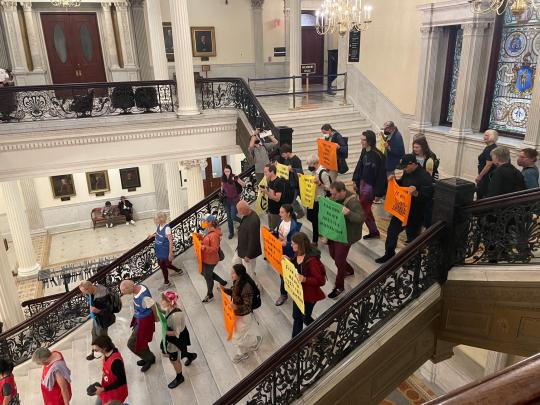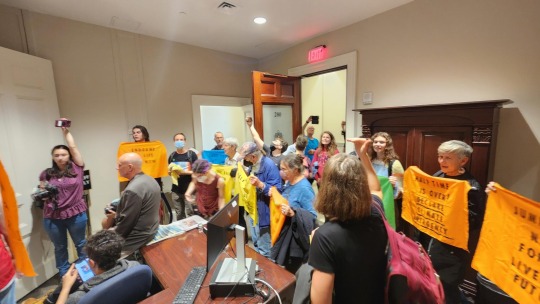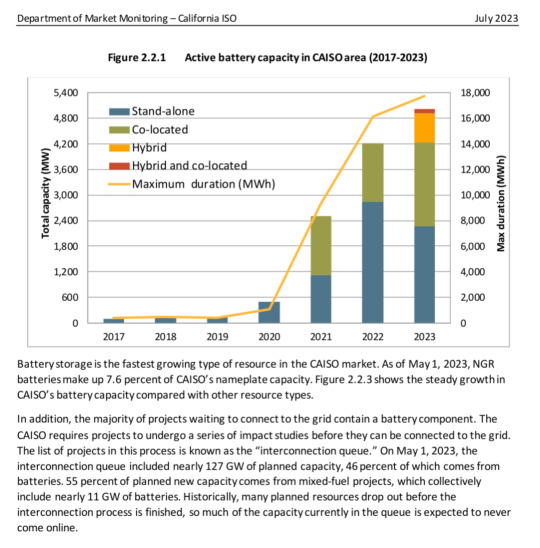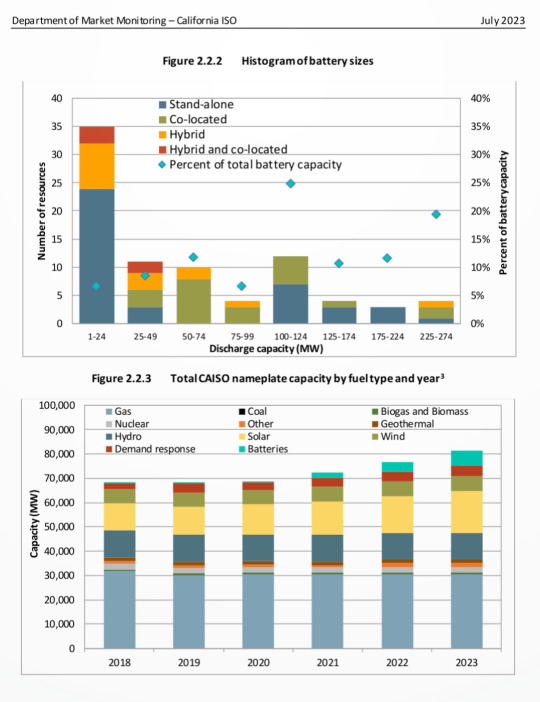#peaker plants
Explore tagged Tumblr posts
Text
Pierre Rochard Corrects Misinformation About Bitcoin Mining
Senior Bitcoin mining expert Pierre Rochard took to Twitter today to correct a widely shared Wired article that claimed ERCOT, Texas’ grid operator, pays Bitcoin miners to curtail during high demand periods. The false claim suggests that miners were financially incentivized to turn off their operations to ease grid stress. Rochard, pointing out the misinformation, clarified that ERCOT does not,…
#Ancillary Services#Bitcoin miners#bitcoin mining#competitive market.#curtailment#energy management#ERCOT#frequency support#grid reliability#misinformation#peaker plants#Pierre Rochard#standby load#Texas grid#Wired article
1 note
·
View note
Text
Excerpt from the Substack Distilled:
In the last few months, the Biden administration has quietly passed multiple federal policies that will transform the United States economy and wipe out billions of tons of future greenhouse gas emissions.
The new policies have received little attention outside of wonky climate circles. And that is a problem.
Earlier this year, I wrote that Biden has done more to mitigate climate change than any President before him. For decades, environmentalists tried and failed to convince lawmakers to pass even the most marginal climate policies. It wasn’t until Biden took office that the logjam broke and the climate policies flowed. And yet few American voters are hearing this story in an election year of huge consequence.
It’s been two and a half months since I wrote that article. In that short time, the Biden administration has passed a handful of climate policies that will collectively cut more than 10 billion tons of planet-warming pollution over the next three decades, more than the annual emissions of India, Russia, Japan, South Korea, Canada, Saudi Arabia, and the entire continent of Europe—combined.
One climate policy that flew under the radar recently was the administration's latest energy efficiency rule, unveiled at the beginning of May. The new rules will reduce the amount of energy that water heaters use by encouraging manufacturers to sell models with more efficient heat pump technology. The new regulation is expected to save more energy than any federal regulation in history.
Most people give little thought to how the water in their homes is heated, but water heaters are the second-largest consumer of energy in the average American home and one of the largest sources of climate pollution in the country.
A few days before the administration announced its water heater efficiency rules, the Environmental Protection Agency (EPA) announced another sweeping policy.
According to the new rules, existing coal power plants will need to either shut down or install carbon capture technology capable of removing 90% of their carbon pollution. The policy will also require any new natural gas power plants that provide baseload power—the ones that run throughout the day and night, as opposed to the peaker plants that only run for a small fraction of hours in the year—to install carbon capture technology.
The new power sector rules are effectively a death blow to coal power in America, which has slowly faded over the last two decades but still emits more carbon emissions than almost every country in the world.
The water heater rules and power plant regulations will help the country meet its goal of cutting emissions by 50% by 2030. But impactful as they will be, they weren’t the most important climate policy that the Biden administration passed in the last two months.
That honor goes to the EPA’s tailpipe rules, which are set to transform the auto industry over the next decade.
Today the transportation sector is the largest source of climate pollution in the United States. Within the sector, passenger cars and trucks are the biggest contributors to emissions. While electric vehicle adoption has grown in recent years, America lags behind many other countries in decarbonizing its vehicle stock.
The EPA’s new rules will force automakers to reduce the amount of pollution and carbon emissions that come from their vehicles. The federal policy doesn’t specifically mandate that automakers produce EVs or stop selling gas-powered cars but instead regulates the average carbon emissions per mile of a manufacturer's entire fleet over the next decade. That means automakers can still sell gas-guzzling, carbon-spewing trucks in 2035. They’ll just need to sell a lot more EVs or plug-in hybrids to bring their average fleet emissions down if they do.
Like the power plant rules, the EPA’s new auto regulations are designed to avoid being thrown out by a conservative and hostile Supreme Court.
128 notes
·
View notes
Text
Claire Elizabeth Beauchamp Randall Fraser (Grey)
I wanted to go to sleep, happy enough with a no drama birthday.
Something was nagging me in this very carefully worded donation statement:

Why Claire Beauchamp?
Why not Claire Fraser, which would have been the logical - hell, obvious! - choice?
So I was tossing & turning and instead of counting sheep, I was entertaining the earworm... "Beauchamp.... Beauchamp... Beauchamp"...
And then...

... BUT OF COURSE!
Remember this?

The mythical Hyde Park Walk, when ...uhm... things were said. Following which, a decision to have each other's back was made & set in stone.
I don't think (correct me if I am wrong) we do have the precise day for this pivotal moment in the S&C saga. But we know it was September 2013 and certainly after 9/11/2013, when C was cast as Beauchamp, hehe.
Remember also this?

... followed by this:

Two can play that game, indeed.
Something happened between 9/11/2013 and 9/16/2013. Five days (that shook their world, to paraphrase John Reed's seminal book on the Russian Bolshevik Revolution).
I amused myself a lot with Google Maps, tonight:

It's a ten minutes walk from Hyde Park to Beauchamp Place. Ok, fifteen, at a more leisurely pace.
I would also suggest checking @ashmarie1687's post on this topic (https://ashmarie1687.tumblr.com/post/637622028553289728/where-it-all-began). I am not the only loon who connected these dots.
Tomorrow, I will be crucified for this, for sure. But just tell me: do you have a better explanation for this donation the size of the Spanish Indies, and then some more?
What fan would be so pathologically invested, as to remember these details and act upon them and state them in charming charade form?
Thought so.
Only a person involved in that 'two can play that game' episode would say Beauchamp instead of Fraser, exactly ten years after the facts occured.
A milestone, indeed.
Ok, Sir. Your kilt is showing. :) And this is the sweetest trolling of this entire fandom to date.
I rest my case.
[edit]: Thanks to Mushka's tantrum on X, I am now aware that OTP is One Tree Planted, the NGO chosen by S for the yearly MPC's big charity project in 2022. That good man spent his birthday planting trees on behalf of OTP with Peakers, by the way (https://onetreeplanted.org/blogs/stories/my-peak-challenge):

178 notes
·
View notes
Text
"Merrimack Station, which is New England’s last running coal plant, will stop operating in 2028.
Granite Shore Power announced the closure of the Bow plant as part of a settlement agreement signed Wednesday, resolving litigation brought by the Conservation Law Foundation and the Sierra Club. Granite Shore Power will commit to shutting down coal-fired generators at the Schiller Station in Portsmouth by 2025. Currently, that plant has the capability to burn coal but hasn’t used its coal-fired generation since 2020.
Merrimack Station is a peaker plant, used to provide power on the region’s hottest or coldest days. In New England, coal makes up less than 1% of the region’s energy.
Granite Shore Power says the two plants will become “renewable energy parks.” Schiller Station is set to host a battery storage system that can provide power to the grid when there’s a lot of demand, and could serve as storage for offshore wind power.
Merrimack Station is expected to host about 100 megawatts of solar, along with more battery storage."
74 notes
·
View notes
Text

Australian community battery program cuts power bills and strengthens the grid
Australia’s community battery programme is reducing household electricity bills, cutting greenhouse gas emissions, and bolstering the national grid, policymakers and analysts say.
Under the Community Batteries for Household Solar scheme, which has A$200 million (US$133 million) in state grant funding at its disposal, 400 batteries are being installed in neighbourhoods across the country. Up to 100,000 households will have access to these facilities, allowing them to store excess solar energy for use during peak times — typically in the mornings and evenings.
The programme is aimed, in part, at encouraging more households to install rooftop solar systems. It will also allow households that can’t install solar panels or their own batteries to access clean energy, and will reduce the country’s reliance on costly and polluting gas peaker plants.
While still a relatively new concept, the benefits are starting to show up.
Source
#solarpunk business#solarpunk business models#solarpunk#solar punk#community#energy#renewable energy#solar power#battery#energy storage#australia
8 notes
·
View notes
Text
if I have random downtime to longpost in the next couple weeks I was thinking about a couple things
- the recycling post that's been kicking around in my mind for a while
- how California's solar (semi-)surplus works, why marginal energy prices go negative when fossil fuels are still online, peaker plants & baseline load generation etc - i.e. "part of what's hard about solar"
- EV vs gas car safety, specifically w/r/t battery fires and/or major recalls
the last one I have the least domain expertise in but it's interesting to me BECAUSE the main EV battery fire safety reporting that I could find all hinges on one "study" by an insurance company that claims to have drawn from databases that don't exist, but like 17 newspapers take this reporting at face value. Digging deeper into what's going on with that and at least talking about that data issue in particular is really intriguing
8 notes
·
View notes
Text
#please sign and share#petition#petitions#please sign this petition#please share#please sign#climate action#climate science#climate activism#go green
6 notes
·
View notes
Text
XR Boston plays basketball in halls of MA State House to demand Governor ban new fossil fuel infrastructure
On Monday September 18, more than 30 climate activists from Extinction Rebellion Boston (XR) played a creative version of basketball in the halls of the Massachusetts State House, to demand that Governor Maura Healey "stop playing games with our future." The activists split into two "teams," one team representing the government (with sponsorship logos for fossil fuel companies on their jerseys) and the other team representing "New Fossil Fuels". On the second floor outside Governor Healey's office, activists made raucous throwing and dribbling motions, while shouting as if in game-play. Meanwhile, other activists playing the role of Massachusetts residents as spectators carried banners and shouted for the game to end. Spectator chants included: "Commonwealth, you’re breaking the rules, don’t pass the ball to Fossil Fuels! You’re our home team, we must win! It’s our planet, go all-in! Fossil fuels, aren’t you ashamed? It’s our future, not a game! We see your fouls to make a basket, there’s no games on a dead planet!" These activists managed to disrupt business as usual for a full afternoon. After a long game, the crowd of activists occupied the Governor's Constituents office for two hours until eight arrests were made. During the occupation, they chanted together and sang protest songs in high spirits. As arrestees were led away, their cohorts sang "Courage [activist's name], you do not walk alone, we will walk with you, and sing your spirit home."
These activists managed to disrupt business as usual for a full afternoon. After a long game, the crowd of activists occupied the Governor's Constituents office for two hours until nine arrests were made. During the occupation, they chanted together and sang protest songs in high spirits. As arrestees were led away, their cohorts sang "Courage my friend, you do not walk alone, we will walk with you, and sing your spirit home."
Extinction Rebellion Boston's demand is No New Fossil Fuel Infrastructure in Massachusetts.
Banning new fossil fuel infrastructure includes:
NO new fossil fuel power plants
NO new residential or commercial gas connections
NO new or expanded natural gas distribution pipelines, transmission pipelines, or compressor stations
NO new liquified natural gas production facilities, storage facilities, or terminals
NO new gas stations or other gasoline and diesel infrastructure
NO new airports or airfield expansions
Stopping new fossil fuel infrastructure under development includes:
MMWEC’s Peaker Plant in Peabody
NEC’s Liquified Natural Gas Facility in Charlton
LNG expansion to Douglas
L.G. Hanscom Airfield's North Airfield Development in Bedford
"Modernization" projects in Lowell and Worcester
"Reliability" projects in Western Mass. and Sharon-to-Brockton
The Hopkinton-Ashland Transfer Line
Meter stations in Longmeadow and Charlton
Why are we using creative disruption? Asking nicely hasn't kept humanity safe from the effects of climate change, neither has writing letters and petitions, neither has hopes and prayers. The global average temperature for July 2023 is confirmed to be the highest on record for any month, and August 2023 was the hottest August in recorded history. We gasp through wildfire smoke, and our neighbors to the north wade through floodwaters. What more will it take before our government takes action?
Full article here: https://xrboston.org/news/xr-boston-plays-basketball-in-halls-of-ma-state-house-to-demand-healey-administration-ban-new-fossil-fuel-infrastructure/









#extinction rebellion#climate activism#civil disobedience#state house#massachusetts#Maura Healey#basketball#chanting#fossil fuels
3 notes
·
View notes
Text
The Future of Energy: Exploring the Benefits of a 5 MWh Battery Energy Storage System
In today’s rapidly evolving energy landscape, innovative solutions are essential for meeting the growing demands for reliable and sustainable power. Good Enough Energy, a leader in energy solutions, is proud to highlight the potential of a 5 MWh battery energy storage system in revolutionizing energy storage and distribution.
What is a 5 MWh Battery Energy Storage System?
A 5 MWh battery energy storage system refers to a system capable of storing 5 megawatt-hours of energy. This means it can deliver 5 megawatts of power for one hour or 1 megawatt of power for five hours, depending on the demand. Such systems are vital for enhancing grid stability, integrating renewable energy, and improving energy efficiency across various applications.
Key Benefits of a 5 MWh Battery Energy Storage System
1. Enhanced Grid Reliability
One of the primary advantages of a 5 MWh battery energy storage system is its ability to support grid reliability. By storing excess energy during low-demand periods and discharging it during peak demand, these systems help balance supply and demand effectively.
2. Integration of Renewable Energy
Renewable energy sources like solar and wind are intermittent by nature. A 5 MWh battery energy storage system enables the seamless integration of these sources by storing surplus energy generated during peak production and making it available when generation is low.
3. Cost Savings and Efficiency
By reducing reliance on peaker plants and minimizing transmission losses, a 5 MWh battery energy storage system can significantly lower energy costs for utilities and consumers. Additionally, it offers a sustainable alternative to traditional energy storage methods.
4. Scalability and Flexibility
These systems are highly scalable and can be tailored to meet the specific needs of different industries, from commercial facilities to large-scale utilities. Their modular design ensures easy expansion as energy demands grow.
Why Choose Good Enough Energy?
At Good Enough Energy we specialize in delivering cutting-edge energy solutions tailored to meet the unique needs of our clients. Our 5 MWh battery energy storage system exemplifies our commitment to sustainability, innovation, and excellence. We provide end-to-end support, from system design and installation to maintenance and optimization, ensuring our clients achieve maximum value and efficiency.
Applications of a 5 MWh Battery Energy Storage System
Renewable Energy Integration: Store solar or wind energy for use during non-productive periods.
Peak Shaving: Reduce energy costs by discharging stored energy during peak pricing hours.
Backup Power: Ensure uninterrupted operations for critical facilities during outages.
Frequency Regulation: Maintain grid stability by responding to fluctuations in frequency in real time.
Conclusion
The 5 MWh battery energy storage system is not just a technology; it is a cornerstone of the transition to a more sustainable and efficient energy future. With the expertise and dedication of Good Enough Energy, businesses and communities can harness the full potential of this transformative solution.
Invest in the future of energy with Good Enough Energy’s 5 MWh battery energy storage system—a smarter, cleaner, and more reliable way to power the world.
0 notes
Text
One of the US’s first solar peaker plants – with Tesla Megapacks – just came online
🌞
1 note
·
View note
Text
How Smart Energy Technology Can Reduce Costs and Improve Sustainability
Energy consumption is one of the biggest concerns for houses, factories and companies. Smart energy technology can help reduce costs and improve sustainability.
IoT-powered energy management systems enable enterprises to have a comprehensive view of their energy consumption, and uncover patterns that can be used to reduce energy bills.
1. Real-time monitoring
Like a car without a dashboard, a building cannot operate efficiently without a SMART system that monitors temperature, occupancy, indoor air quality and energy use. Real-time monitoring also offers crucial insights into power consumption and redistribution, enabling the development of effective energy management strategies.
Detailed data about energy utilization makes it possible to optimize facilities by adjusting production schedules and machinery operation, improving efficiency, and eliminating waste. Additionally, real-time monitoring can help companies achieve compliance with energy consumption and sustainability regulations by providing the necessary information for reporting and certification purposes.
Many different technologies are available for smart meter communication, depending on the level of granularity and third-party integration capabilities needed. Cellular networks are often the preferred option because they offer a wider range of coverage than RF systems and are less susceptible to interference. However, they may impose additional costs for data transmission. Broadband connections, on the other hand, are a more cost-effective choice but might require significant infrastructure investments in remote areas.
2. Energy storage
It takes a lot of energy to keep the world running. It powers lights, makes cars work and is used for many other everyday functions. But it’s also a big resource that can be wasted.
One way to reduce energy use is by storing it. This can be done through batteries, fuel cells and other technologies. Energy storage helps to balance supply and demand by reducing the need for fossil fuel peaker plants. These plants operate at specific times when demand for electricity spikes, such as during a heat wave.
The other benefit of energy storage is that it allows you to take advantage of off-peak electricity rates. For example, you can use it to lower the cost of charging your electric vehicle or run your dishwasher. This becomes more important the farther you live from a central electrical grid. Studies have shown that energy storage is an essential technology for remote communities, islands and microgrids.
3. Integration of renewable energy sources
Smart energy technology includes many different devices that collect data about how a household uses power and other utilities. These devices can be used to help a home use less electricity and make better decisions about how to use energy in the future.
One of the most popular smart energy technologies is the solar PV system. This device can help a home produce more of its own energy and reduce its dependence on the traditional power grid.
Another example is a smart meter. This device can track energy usage and provide information about the environment. It can also change the way a house uses energy to cut down on waste.
Some research on the adoption of SET has found that knowledge about the benefits can increase the likelihood of buying the device. This is particularly important for low-income households, who may have trouble affording more expensive solutions. Other factors that can influence the adoption of SET include the availability and perceived ease of use of the technology.
4. Recycling of industry waste
In addition to reducing energy costs, smart technology will help businesses and citizens recycle more of their industry waste. This will involve designing new products with better end-of-life processes that make it easier to disassemble, refine, remanufacture and reuse their components. It will also require government mandates that limit their wanton disposal and effective regulatory structures to incentivize the private sector to invest in companies and infrastructure to collect, transport, reprocess and recycle them.
Moreover, the decentralized nature of smart energy systems will improve resilience to disasters like hurricanes and heatwaves by generating local electricity in affected areas, alleviating the burden on centralized power generation technologies. Furthermore, recent studies show that consumers are willing to pay a premium for sustainably-marketed consumer products.
0 notes
Text
Maximizing Battery Efficiency: Cutting-Edge Energy Storage Analysis Solutions
In the renewable energy sector, optimizing battery performance and lifespan is crucial for ensuring reliable and sustainable energy storage. With the growing reliance on renewable sources like solar and wind, effective energy storage solutions are necessary to balance supply and demand, providing a steady energy supply even when the sun isn’t shining or the wind isn’t blowing. This blog explores the latest innovations and companies at the forefront of energy storage analysis solutions.
The Importance of Battery Efficiency in Renewable Energy
Renewable energy sources are inherently variable, creating a need for efficient energy storage systems. Batteries are key to this, but their performance and lifespan are affected by numerous factors, including charge/discharge cycles, temperature, and usage patterns. Optimizing these parameters can significantly enhance battery efficiency and longevity, thereby improving the overall viability and cost-effectiveness of renewable energy systems.
Innovations in Energy Storage Analysis Solutions

AI and Machine Learning Algorithms
Artificial Intelligence (AI) and Machine Learning (ML) are revolutionizing battery management. These technologies analyze vast amounts of data from battery usage, environmental conditions, and other factors to predict and optimize battery performance. Companies like Stem Inc. and Fluence are utilizing AI-driven platforms to manage and optimize energy storage systems effectively.
Stem Inc. uses AI to manage its energy storage solutions, ensuring that batteries are charged and discharged in the most efficient manner possible. Their platform, Athena, uses predictive analytics to optimize energy storage, reducing costs and enhancing the reliability of renewable energy systems. Athena’s predictive analytics capabilities allow it to forecast energy demand and supply by analyzing historical and real-time data, enabling strategic charging and discharging of batteries. This improves efficiency and reduces operational costs, making renewable energy more competitive with traditional sources.
Fluence's AI-driven energy storage solutions are exemplified by their use in the Australian Hornsdale Power Reserve, one of the world’s largest lithium-ion batteries. The system has significantly improved grid stability and reduced energy costs. Fluence’s technology allows the system to respond to fluctuations in energy supply and demand within milliseconds, providing a reliable backup during peak usage times. This capability not only stabilizes the grid but also reduces the need for expensive and polluting peaker plants, making renewable energy more viable and environmentally friendly.
Advanced Battery Management Systems (BMS)
Modern BMS are equipped with sophisticated sensors and software that monitor and manage the state of charge, state of health, and thermal management of batteries. These systems can dynamically adjust operations to extend battery life and improve efficiency.
Tesla’s Powerwall and Powerpack systems incorporate advanced BMS technology, enabling better performance and longer lifespan. Tesla’s BMS continuously monitors battery conditions and adjusts parameters to maximize efficiency. The system includes multiple layers of monitoring and control, ensuring that each battery cell operates within optimal parameters. This minimizes wear and tear, reduces the risk of failures, and extends the overall lifespan of the battery. Additionally, Tesla’s BMS can communicate with the grid, allowing for seamless integration and efficient energy management.
NextEra Energy’s Manatee Energy Storage Center in Florida is set to be one of the largest solar-powered battery systems in the world, enhancing the efficiency and reliability of renewable energy. The center is designed to store excess solar energy generated during the day and release it during the evening or cloudy periods, ensuring a continuous supply of clean energy and helping balance the grid. The large-scale battery system can store enough energy to power tens of thousands of homes, demonstrating the scalability of battery storage solutions in supporting renewable energy.
Solid-State Batteries
Solid-state batteries are emerging as a promising technology, offering higher energy densities, improved safety, and longer lifespans compared to traditional lithium-ion batteries. These batteries use a solid electrolyte instead of a liquid one, reducing the risk of leakage and improving thermal stability.
QuantumScape, a leading company in solid-state battery technology, has made significant strides in developing batteries that can store more energy and last longer, making them ideal for renewable energy applications. By replacing the liquid electrolyte with a solid material, these batteries can achieve higher energy densities, storing more energy in the same amount of space. Additionally, solid-state batteries are less prone to overheating and thermal runaway, enhancing their safety and reliability. QuantumScape’s innovations are particularly promising for large-scale energy storage systems and electric vehicles.
Northvolt, a Swedish battery manufacturer, is dedicated to producing the world's greenest batteries with a minimal carbon footprint. Their partnership with Volkswagen to develop a battery factory in Germany aims to produce high-performance batteries for electric vehicles and energy storage systems, advancing renewable energy integration. Northvolt focuses on recycling and reducing the carbon footprint of battery production, addressing major environmental concerns associated with battery technology. The collaboration with Volkswagen aims to create a closed-loop system where batteries can be recycled at the end of their life, reducing waste and conserving resources. This approach supports renewable energy and promotes a circular economy.
Optimizing battery efficiency is vital for the success of renewable energy systems. Advances in AI, BMS technology, and solid-state batteries are paving the way for more efficient and longer-lasting energy storage solutions. Companies like Stem Inc., Fluence, Tesla, QuantumScape, NextEra Energy, and Northvolt are leading the charge with innovative technologies and real-life applications that are making a significant impact on the renewable energy landscape. By maximizing battery efficiency, we can enhance the sustainability and reliability of renewable energy, driving us closer to a cleaner, greener future. These advancements in battery technology and energy storage solutions are not just theoretical. They are being implemented in real-world projects and making tangible differences in the way we harness and utilize renewable energy. As these technologies continue to evolve and improve, they hold the promise of transforming our energy systems, making renewable energy more reliable, efficient, and accessible to all. We need to keep up with all recent innovations to reap maximum benefits and to facilitate a better understanding of the latest developments and trends in the Renewable energy Industry, various Conferences and Expos, which bring Industry leaders together, serve as an all-inclusive platform. The Energy Evolution Awards, Conference, and Expo organized by Next Business Media is making its debut in Spain in 2025. It will be a leading forum dedicated to honoring excellence in Energy Technology, showcasing innovations, and fostering collaborations. The events unite industry leaders, and visionaries to explore the latest advancements, tackle key challenges, and shape the future of Energy. The Energy Evolution Awards, Conference, and Expo will celebrate outstanding achievements, promote sustainable practices, and drive the Energy Industry forward into a technologically advanced sustainable era. Energy Evolution Awards, Conference, and Expo will be a platform for cultivating innovation and shaping a brighter, more efficient energy landscape.
0 notes
Text
Plan to expand power plant in Newburgh, New York withdrawn
Plan to expand power plant in Newburgh, New York withdrawn Edwin J. Viera24 Jun 2024, 11:13 GMT+10 The original plan called for expanding the company’s “peaker plant” meant to handle times of peak electricity, to a baseload plant providing power throughout the year. New York state’s Department of Environmental Conservation denied the air permits and the project faced legal setbacks. Residents…

View On WordPress
0 notes
Text
In one of the US's hottest deserts, utilities push gas rather than solar
https://www.theguardian.com/us-news/article/2024/may/23/gas-peaker-plant-republicans-fort-mohave-arizona
0 notes
Text

I’m curious to know which 83 countries have joined the global MPC movement that connects people. 🤔 In this video SH appeared to be associated with @OceanConservancy on World Cleanup Day 2023, cleaning plastic off of beaches. However, MPC did not participate in this global event. SH was alone in the original video, and not surrounded by his peakers. After watching the video, is reasonable to ask some questions.

It is important to remind SH and his peaks of something important to avoid a repeat of the irregularity that took place during their last MPC party in April 2022. MPC "peakers" are tourists/visitors who can volunteer for up to 30 days ONLY to a registered charity in Scotland.
In 2022, these MPC tourists visited Scotland and worked for free for SH's gardener friend, planting fruit trees 🍃 🍎 in an apple orchard at Castleton Farm in East Lothian, outside Edinburgh, and supporting a private commercial property, the " Morning Cider", by Scottish Ciders an urban cidery company. The company is private and was not and is not registered as a charity in Scotland, diverting the law towards its objectives.

The purpose of planting fruit trees was not to reforest the area but to expand the production and apple delivery to the market with the help of MPC women volunteers, and now these events are part of MPC 2024 as commendable work. Any irregular activities are not acceptable, and SH needs to understand if doing something illegal he’s breaking the law.
Under British law, tourists/visitors cannot carry out paid or unpaid work for a UK company or as self-employed workers. It is therefore interesting to identify which Scottish registered charity, SH will be taking its Peakers to work as part of its birthday commemoration in 2024. MPC's annual charity partner this year is the World Wildlife Fund (WWF). Could his Peakers ADOPT AN ANIMAL NOW as a birthday present?🎁
It's surprising how audacious he is. This MPC video is not helping him in any way. If you game the system, don't be surprised when the game turns against you.




#volunteering #immigrationrules #visitors
0 notes
Text
when talking about the grid, getting data from even a couple years earlier can give you a pretty different picture! The below chart shows the battery storage capacity of CAISO (which is more or less California's electrical grid, with some asterisks) from 2017 to 2023. In 2020, CAISO could deliver about 500 megawatts of power from batteries and could store about one gigawatt-hour of energy. Just three years later, it could deliver ten times that power and store almost eighteen times that much energy.

(given it's almost a year later, I wish I had an updated graph to provide for 2024!)

As of July 2023, batteries made up less than 10% of CAISO'S total capacity - but that's changing rapidly. For one, the vast majority of projects scheduled to be added to the grid in the next several years include a storage component. For two, the more storage available for the 4-9 ramp (when solar goes offline), the more fossil fuel plants can be taken off the grid completely. Much capacity is currently dedicated to being able to quickly increase output at 4 PM - because of the mechanical inertia of gas turbines, it takes a long time for them to start generating, so often they stay operating during the day to be able to operate at night. Smoothing the evening peak means daytime fossil fuel use can drop! For three, some of the most potent bottlenecks for increasing the fraction of solar in CA are transmission line capacity and demand: CA already regularly generates far more solar than it can use at any given moment in the winter, but not all that energy can be transmitted to the right place at the right time. Getting more storage on the grid means being able to better use resources we already have.
One more thing: Because the rarely-used peaker plants are often the least efficient/dirtiest, reducing their use has disproportionate impact. CAISO's emissions by month for the last several years are available on its app, ISO Today:

For some months, emissions from electricity generation have been cut in half! (This isn't just because of peaker plants, but it's cool to see such a strong effect.)
source (PDF)
2 notes
·
View notes